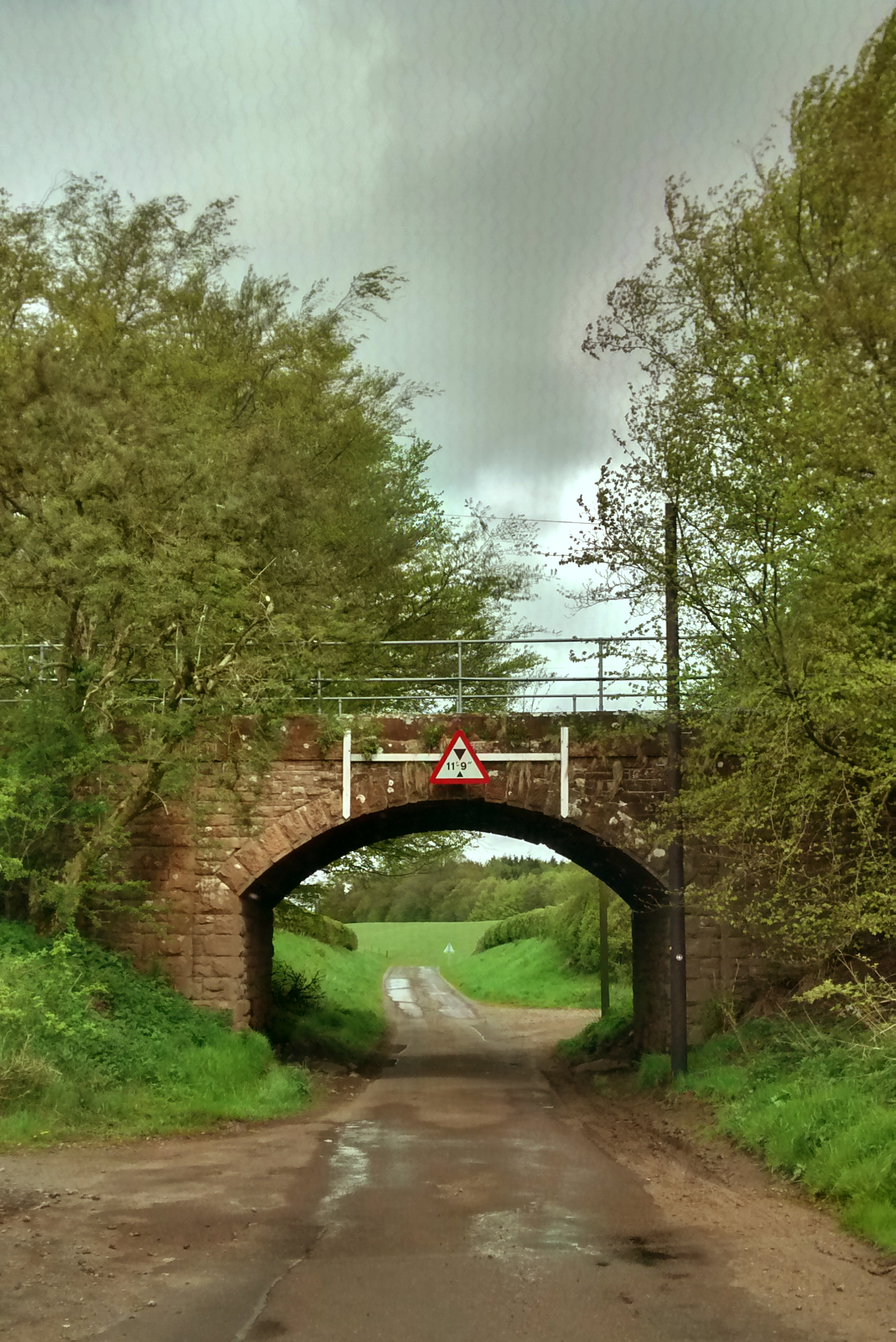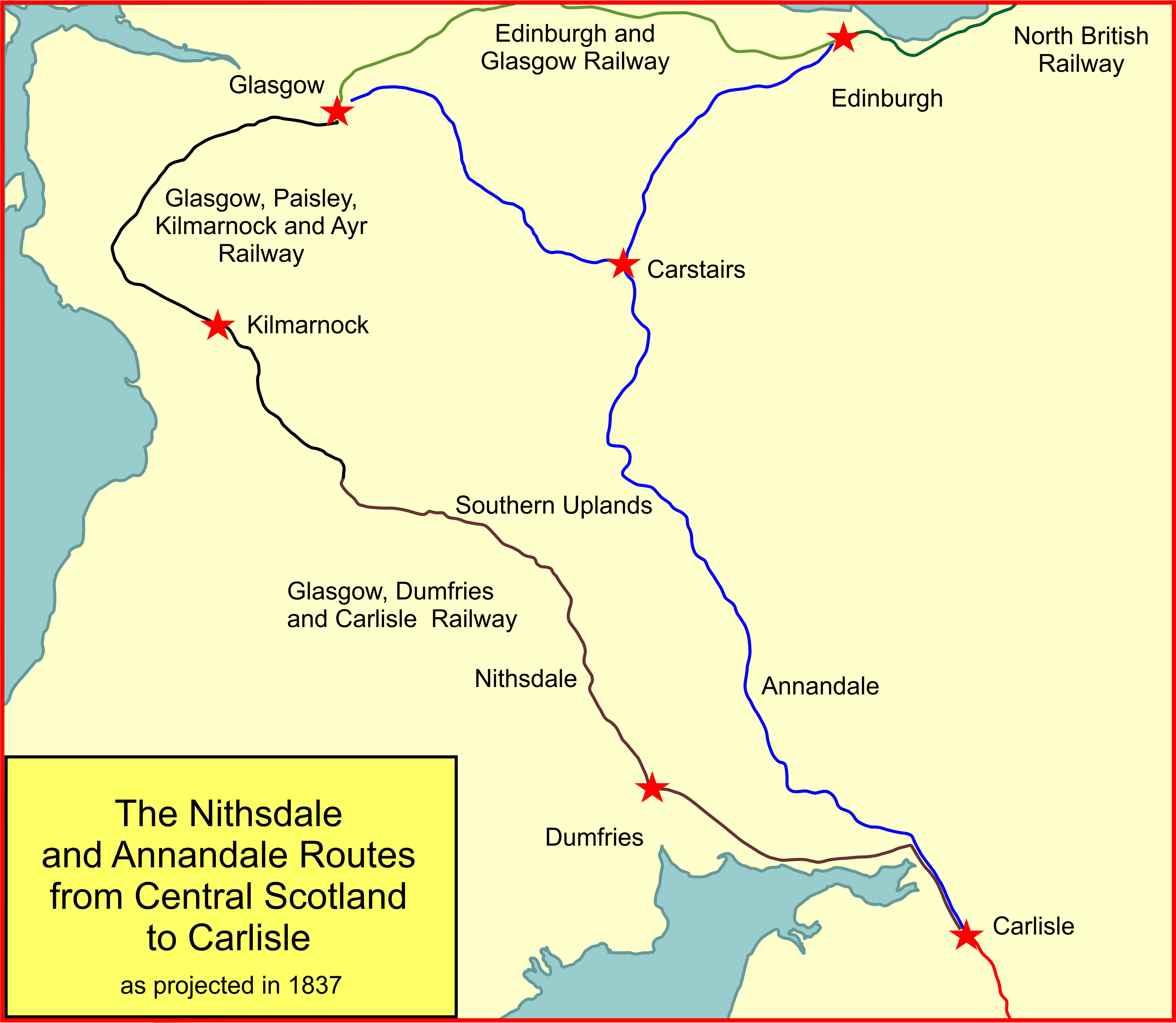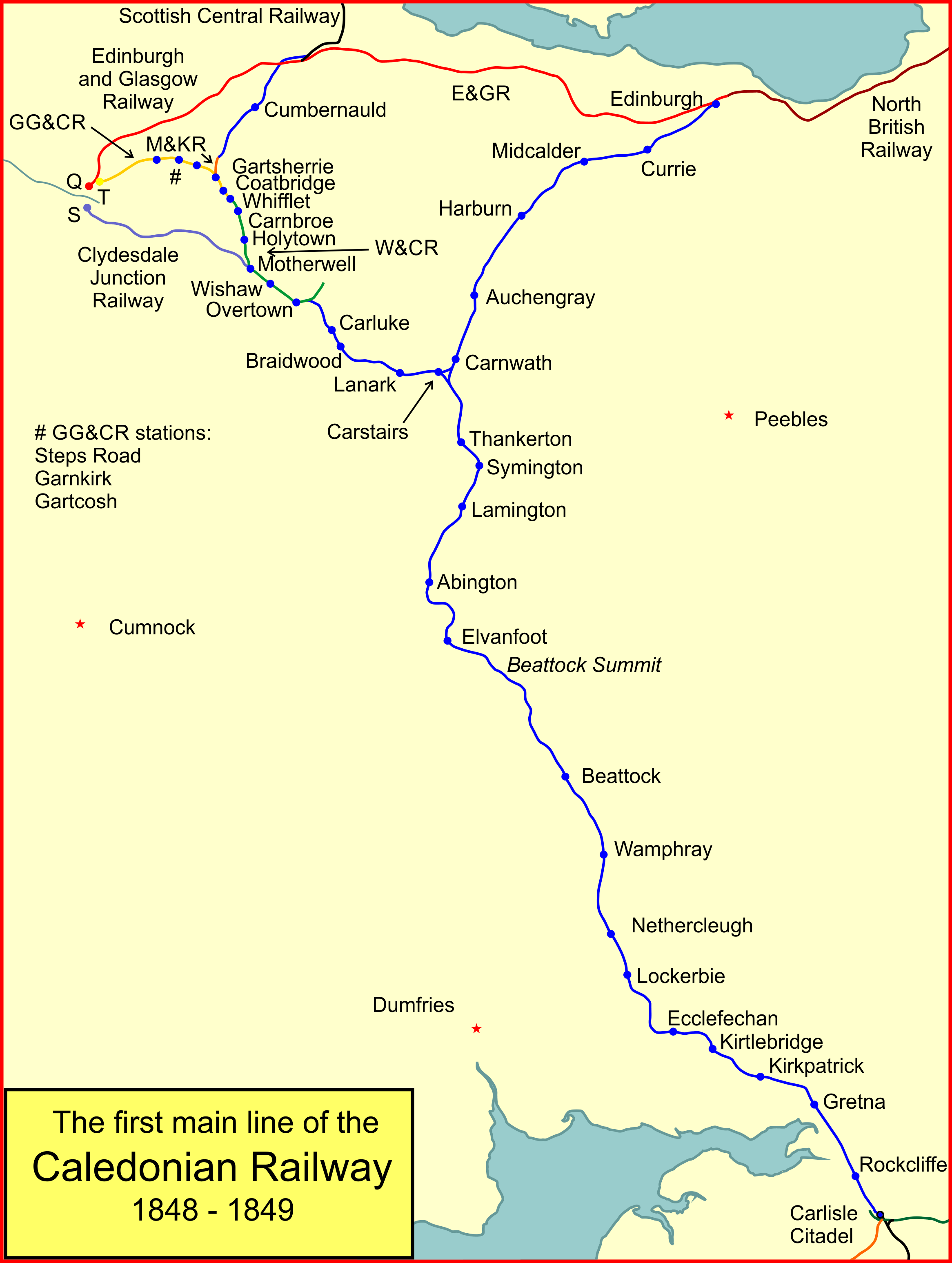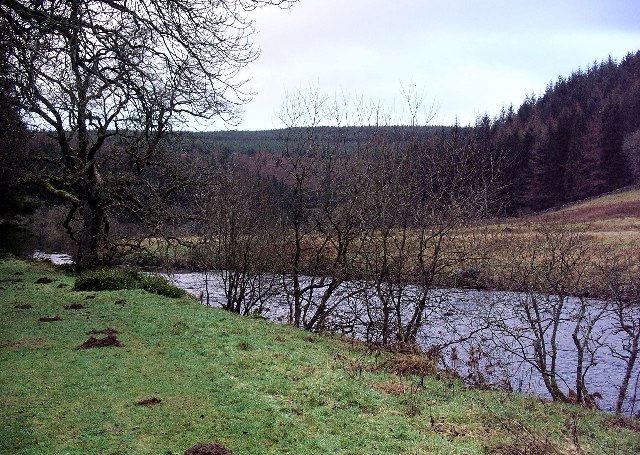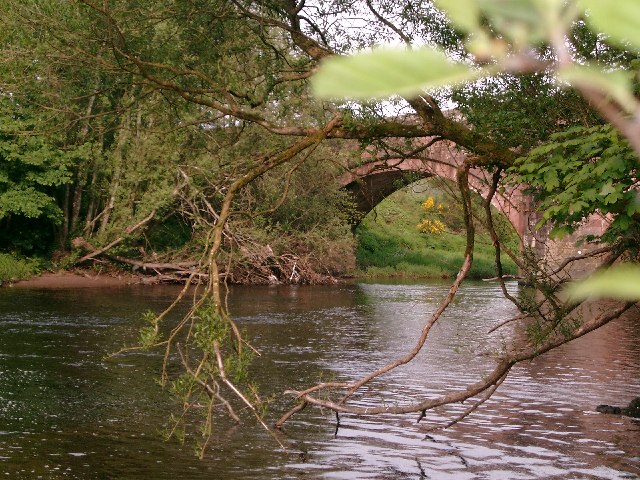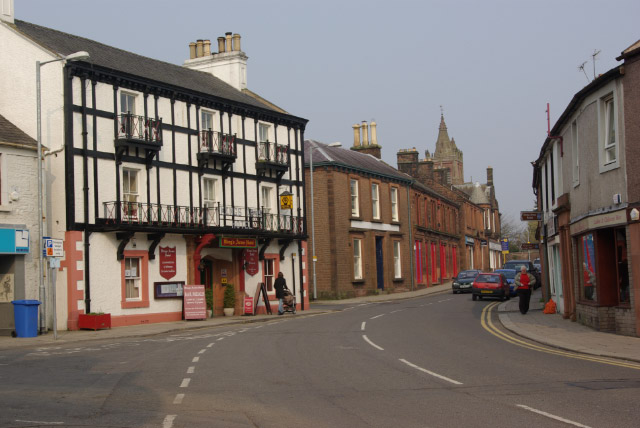|
Dumfries, Lochmaben And Lockerbie Railway
The Dumfries, Lochmaben and Lockerbie Railway was a railway in Dumfriesshire, Scotland. It connected Dumfries with Lockerbie via Lochmaben. Promoted independently, it was absorbed by the Caledonian Railway to give access to Dumfriesshire and later to Portpatrick for the Irish ferry service. It opened in 1863, closed to ordinary passenger services in 1952, and closed completely in 1966. History Before the local railway In the first years of the nineteenth century, the area round Lochmaben was agricultural. The Burgh of Dumfries was dominant in the area, and the stage route between Carlisle and Glasgow and Edinburgh ran through Lockerbie. There had traditionally been significant trade movement along the Lockerbie - Lochmaben - Dumfries road.The New Statistical Account of Scotland, no. IX, Blackwood and Sons, Edinburgh, 1836 In 1847 the Caledonian Railway (CR) opened its main line through Lockerbie.David Ross, ''The Caledonian: Scotland's Imperial Railway: A History'', Stenlake P ... [...More Info...] [...Related Items...] OR: [Wikipedia] [Google] [Baidu] |
Caledonian Railway
The Caledonian Railway (CR) was a major Scottish railway company. It was formed in the early 19th century with the objective of forming a link between English railways and Glasgow. It progressively extended its network and reached Edinburgh and Aberdeen, with a dense network of branch lines in the area surrounding Glasgow. It was absorbed into the London, Midland and Scottish Railway in 1923. Many of its principal routes are still used, and the original main line between Carlisle and Glasgow is in use as part of the West Coast Main Line railway (with a modified entry into Glasgow itself). Introduction In the mid-1830s, railways in England evolved from local concerns to longer routes that connected cities, and then became networks. In Scotland it was clear that this was the way forward, and there was a desire to connect the Central Belt to the incipient English network. There was controversy over the route that such a line might take, but the Caledonian Railway was formed on ... [...More Info...] [...Related Items...] OR: [Wikipedia] [Google] [Baidu] |
Railways Act 1921
The Railways Act 1921 (c. 55), also known as the Grouping Act, was an Act of Parliament enacted by the British government and intended to stem the losses being made by many of the country's 120 railway companies, by "grouping" them into four large companies dubbed the " Big Four". This was intended to move the railways away from internal competition, and retain some of the benefits which the country had derived from a government-controlled railway during and after the Great War of 1914–1918. The provisions of the Act took effect from the start of 1923. History The British railway system had been built up by more than a hundred railway companies, large and small, and often, particularly locally, in competition with each other. The parallel railways of the East Midlands and the rivalry between the South Eastern Railway and the London, Brighton and South Coast Railway at Hastings were two examples of such local competition. During the First World War the railways were under st ... [...More Info...] [...Related Items...] OR: [Wikipedia] [Google] [Baidu] |
Railway Companies Established In 1860
Rail transport (also known as train transport) is a means of transport that transfers passengers and goods on wheeled vehicles running on rails, which are incorporated in tracks. In contrast to road transport, where the vehicles run on a prepared flat surface, rail vehicles (rolling stock) are directionally guided by the tracks on which they run. Tracks usually consist of steel rails, installed on sleepers (ties) set in ballast, on which the rolling stock, usually fitted with metal wheels, moves. Other variations are also possible, such as "slab track", in which the rails are fastened to a concrete foundation resting on a prepared subsurface. Rolling stock in a rail transport system generally encounters lower frictional resistance than rubber-tyred road vehicles, so passenger and freight cars (carriages and wagons) can be coupled into longer trains. The operation is carried out by a railway company, providing transport between train stations or freight customer faciliti ... [...More Info...] [...Related Items...] OR: [Wikipedia] [Google] [Baidu] |
Early Scottish Railway Companies
{{disambiguation, geo ...
Early may refer to: History * The beginning or oldest part of a defined historical period, as opposed to middle or late periods, e.g.: ** Early Christianity ** Early modern Europe Places in the United States * Early, Iowa * Early, Texas * Early Branch, a stream in Missouri * Early County, Georgia Other uses * ''Early'' (Scritti Politti album), 2005 * ''Early'' (A Certain Ratio album), 2002 * Early (name) * Early effect, an effect in transistor physics * Early Records, a record label * the early part of the morning See also * Earley (other) Earley is a town in England. Earley may also refer to: * Earley (surname), a list of people with the surname Earley * Earley (given name), a variant of the given name Earlene * Earley Lake, a lake in Minnesota *Earley parser, an algorithm *Earley ... [...More Info...] [...Related Items...] OR: [Wikipedia] [Google] [Baidu] |
Glasgow, Dumfries And Carlisle Railway
The Glasgow, Dumfries and Carlisle Railway was a railway company in Scotland, which constructed the line from near Cumnock to Gretna Junction, forming the route from Glasgow to Carlisle via Dumfries, in association with other lines. Its promoters hoped it would form the only railway between central Scotland and England, but it lost out to rival companies. It opened in stages between 1846 and 1850, and on completion of its line it merged with the Glasgow, Paisley, Kilmarnock and Ayr Railway. The combined company took the name Glasgow & South Western Railway (G&SWR). The G&SWR formed an alliance with the English Midland Railway and for many years express passenger trains ran between Glasgow and London over the routes. The line is open today, continuing to form part of the Glasgow - Kilmarnock - Dumfries - Carlisle line; but that has diminished in importance and is now a secondary route. Passenger services are operated by ScotRail. History A line into Ayrshire, and later to En ... [...More Info...] [...Related Items...] OR: [Wikipedia] [Google] [Baidu] |
Caledonian Main Line
The Caledonian Railway main line in Scotland connected Glasgow and Edinburgh with Carlisle, via Carstairs and Beattock. It was opened in 1847 by the Caledonian Railway. The approach to Glasgow used railways already built, primarily for mineral traffic; these were later by-passed by a more direct route. Today, the route forms the northern section of the West Coast Main Line, and was electrified in the early 1970s. Opening From 1830 onwards considerable attention was given to the means by which Glasgow and Edinburgh might be connected to London, and as English railways began to develop into a network, the urgency of making a railway accelerated. The difficult terrain of the Southern Uplands and Cumberland made the selection of a route controversial. After much difficulty, the Caledonian Railway was authorised to build a line via Beattock; this was known as the ''Annandale Route''. On 10 September 1847 the line was opened between Carlisle and Beattock. The station at Carlisle ... [...More Info...] [...Related Items...] OR: [Wikipedia] [Google] [Baidu] |
Railway Turntable
In rail terminology, a railway turntable or wheelhouse is a device for turning railway rolling stock, usually locomotives, so that they can be moved back in the direction from which they came. Naturally, it is especially used in areas where economic considerations or a lack of sufficient space have served to weigh against the construction of a turnaround wye. In the case of steam locomotives, railways needed a way to turn the locomotives around for return trips as their controls were often not configured for extended periods of running in reverse and in many locomotives the top speed was lower in reverse motion. In the case of diesel locomotives, though most can be operated in either direction, they are treated as having "front ends" and "rear ends" (often determined by reference to the location of the crew cab). When operated as a single unit, the railway company often prefers, or requires, that a diesel locomotive is run "front end" first. When operated as part of a multiple ... [...More Info...] [...Related Items...] OR: [Wikipedia] [Google] [Baidu] |
Water Of Ae
The Water of Ae is a tributary of the River Annan into which it flows west of Lockerbie in Dumfries and Galloway administrative county of South West Scotland in the United Kingdom The United Kingdom of Great Britain and Northern Ireland, commonly known as the United Kingdom (UK) or Britain, is a country in Europe, off the north-western coast of the European mainland, continental mainland. It comprises England, Scotlan .... It rises on the eastern slopes of Queensberry. References External linksThe Water of Ae at Bridge of Ae and the village Ae {{Scotland-river-stub ... [...More Info...] [...Related Items...] OR: [Wikipedia] [Google] [Baidu] |
River Annan
The River Annan (''Abhainn Anann'' in Gaelic) is a river in south-west Scotland. It rises on Annanhead Hill and flows through the Devil's Beef Tub, Moffat and Lockerbie, reaching the sea at Annan, Dumfries and Galloway after about 40 miles. Name The etymology of the River Annan is unknown, although some sources suggest it may mean simply "water", from a Celtic language. It gave its name to Annandale, a former stewartry comprising a large portion of modern Dumfriesshire, and to the port town of Annan near its mouth. Description The Annan rises on Annanhead Hill, five miles north of Moffat, near the source of the Tweed ( away), and also close to the source of the Clyde ( away). It then flows through the Devil's Beef Tub, where it is joined by a secondary source that rises on Hartfell. It then flows past the town of Moffat and Lockerbie. Two miles out of Moffat, it is joined by the Moffat Water flowing westward from Loch Skene and the Evan Water flowing eastward from the up ... [...More Info...] [...Related Items...] OR: [Wikipedia] [Google] [Baidu] |
Lockerbie Station Wall
Lockerbie (, gd, Locarbaidh) is a small town in Dumfries and Galloway, south-western Scotland. It is about from Glasgow, and from the border with England. The 2001 Census recorded its population as 4,009. The town came to international attention in December 1988 when the wreckage of Pan Am Flight 103 crashed there following a terrorist bomb attack aboard the flight. Prehistory and archaeology In 2006, ahead of the construction of a new primary and secondary school archaeologists from CFA Archaeology under took excavations. They discovered the remains of a large (27 x 8m) Neolithic timber hall that dated to somewhere between 3950 BC to 3700 BC. The archaeologists found it was in use for some time as some of the posts had been replaced. Flax seeds were found in the timber hall showing the people were processing flax. This is an extremely rare find with only one other site in Scotland showing evidence of flax production in the Neolithic period. Like with most other Neolithic ti ... [...More Info...] [...Related Items...] OR: [Wikipedia] [Google] [Baidu] |
